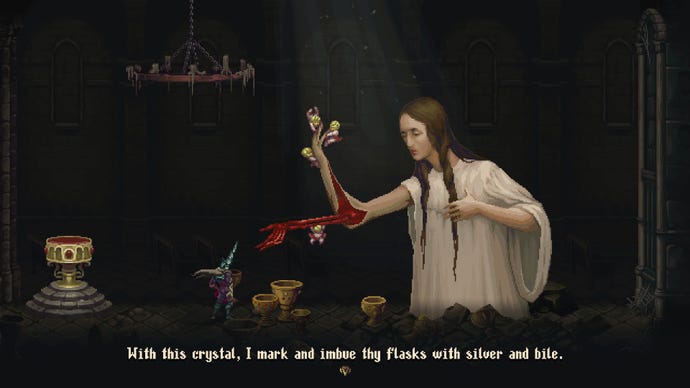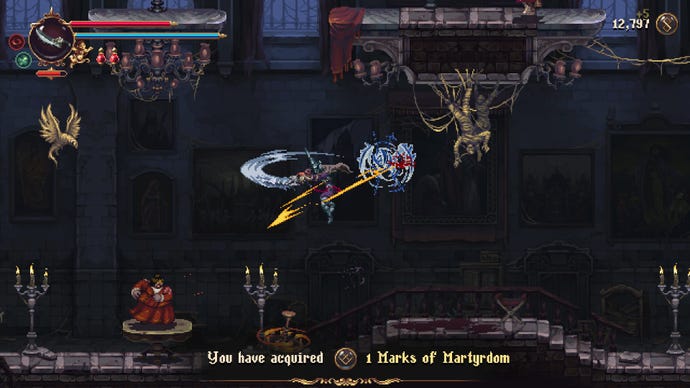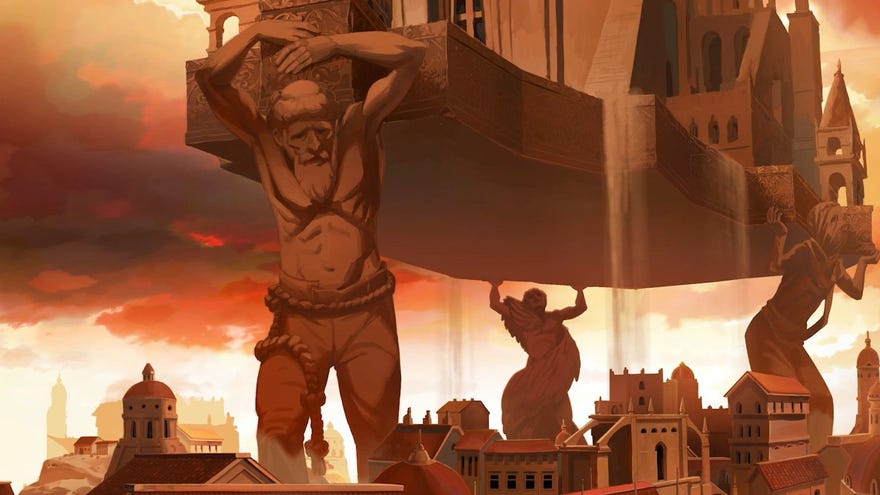Blasphemous 2 review: a worthy 2D Dark Souls tribute drenched in literal Catholicism
Oh Pointy-hatted one
Hear me now, Penitent Ones, for thou are subject to an intro that borrows its style from thine video game. With divine expedience you must go forth into a world from which all unworthy creatures impart their knowledge with great excitations, entangling their speech with a verbosity comparable only to how the holy miracle does imbue our city with its fearsome illumination. If you think this a questionable affectation then guard thyselves, oh Penitent Ones, for you really are in store for an awful lot of this.
Beyond that, Blasphemous 2 is a cracking Metroidvania rooted in satisfying combat and rewarding exploration of the ‘ooh, I didn’t realise this bit was connected to that bit’ vein. Neither element is on the same level of Dark Souls, but then what is?
You’ll need to wrestle with opaqueness in both systems and story, right from the moment you clamber out from a coffin lifted aloft by dozens of statues / possibly statufied citizens, choose one of three weapons, then set out to clobber monsters. A lady on a floating hand soon descends to tell you a giant heart has appeared in the sky, which means you’ll have to go humiliate (murder) the representatives of three giant statues so they’ll kneel down and you can access the city they’re bearing on their backs.
From the perspective of someone who didn’t play Blasphemous 1, this is all baffling but welcome. It swaps Dark Souls’ minimalist approach to dialogue for flowery theology waffle, but preserves that same essense of cryptic storytelling you can either attempt to decipher or just enjoy for its surface weirdness. There’s the same central loop of forging ahead to the next bonfire fountain or shortcut, too, only here we’re explicitly dealing with warped Catholicism, to the point where there is a priest who you have to repeatedly pay to take away your guilt if you want enough mana to cast magic spells. Just like real church.
It’s a striking setting, but your more pressing concern is how to whack things. Combat begins as - and to an extent remains - a matter of clobbering folks then dashing away before they can hit you back, complicated by a smattering of combos, abilities, spells and parries. Each of your three weapons also lets you interact with something that blocks your progress, like teleport mirrors you can stab with your dual rapiers and creepy walls of very-much-alive bodies you can burn away with a sword ground-pound.
That means your starting weapon determines where you can go while you find your footing, and it takes a few hours before you have a full arsenal and can forge ahead into areas that are outright harder. It’s a clever way to weave Metroidvania progress gates into an evolving combat system, and provides a spot of welcome variety for anyone who replays the whole game or accidentally deletes a save file they’ve already ploughed 4 hours into. Woe is me.
In truth I didn’t mind too much, and was even a little glad for the chance to pick the sword and pump my Marks of Martyrdo upgrade points into it from the start. The sword has both the tastiest and most forgiving moveset, with oh-so-satisfying parries that put the flail to shame - though it’s still unfortunate that limited upgrade points incentivise you to largely stick with one weapon rather than switch up mid-combat. There’s plenty to think about elsewhere, though, between your two spell slots (or prayers, if we’re keeping theme) and up to five passive-providing rosary beads. You’ll also want to mull over your array of li’l statues, which grant small-ish buffs by themselves and bigger-ish buffs when placed together in certain hidden combinations. By the end I was freezing time whenever I chugged a health potion and calling down lightning buffs whenever I dodged. Neato.


Wot Blasphemous is best at, though, is animations. Early treats include witches who chuck ghost ravens at you but get devoured by their own very real ravens when they die, roly-poly harpies, creepily-fluid rock-throwing wall statues and lumbering giants who you can execute with their own maces. Some enemies are variants on earlier ones, but more are entirely new threats with their own attack patterns to trip up over and death animations to savour.
The bosses tend to be especially delicious. They never invoke the same level of ‘oh God how do I even...?’ as Dark Souls, but still serve as stumping, session-ending milestones that then feel great to come back and wallop. An early boss whips round and eats the little guy on his back once you’ve stabbed him enough, in explicit Saturn-Devouring-His-Son style. The developers have mentioned they’re inspired by Goya paintings, and it shows. You never know what poor monstrosity you’ll bump into next, but it might be a man cursed to eternally ooze honey.
It’s a world worth seeing, though I do have more muddied thoughts about the way it obfuscates important information, and outright gripes about some systems that did not have to be such a pain. Take something as fundamental as your health, for instance: if you want to embiggen it from its measly starting size, or increase the amount or power of your healing flasks, then it’s up to you to seek out the right character. I missed them until I was about 5 hours in, which to some extent is on me for not thoroughly investigating near the starting area, but nevertheless resulted in pointier difficulty spikes than might have been intended.

I’m aware this is a whole design philosophy, where semi-hiding quasi-vital systems will feel rewarding enough for most but frustrating for those who slip through the cracks. But major quality of life improvements belong where they can’t be missed, says I. I’m the sort of person who dearly wished I was playing post-release with a guide on hand to look up anything that might fit that category, but even so I might have missed certain key finds - most notably, the easily-overlooked prayer that lets you teleport back to town whenever you like, and potentially saves you hours of backtracking.
Some of the frustration can be eased if you diligently mark notable spots on your map, like obstacles you can’t yet pass or, say, a giant weeping breasted man feeding a baby while asking you to plant wax seeds on the cliff next to him. I still don’t know what planting all those did, but I know I wasted 30 minutes trying to track him back down. Oh, and while we’re whining, that guilt priest can get stuffed. Deciding whether to trudge back to him and pay to get your mana back isn’t an interesting decision, it’s an irritant. It gives death some consequence, sure, but even sans trudging I don’t want to spend money on making an inconvenience go away. I want to spend it on cool new powers.
Perhaps that comes down to taste, as does Blasphemous 2’s mean and mysterious vibe in general. The cryptic parts will trip up some people more than others, but even as someone who fell flat on their face I can respect the deft weaving of systems into setting - which is, again, excellent. A few reveals made me say "Jesus Christ!" aloud, then chuckle at the appropriateness. I’d had my fill after the 12 hours it took to pay my penance, leaving a few areas unexplored and some mysteries that remain ravelled, but they’re there for those that want ‘em. By the hallowed murmuring of the sacred Archonfraternity: fill your boots.
This review was based on a review build of the game provided by publishers Team17.

